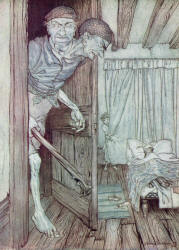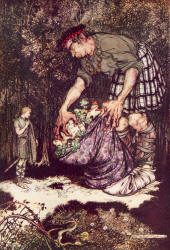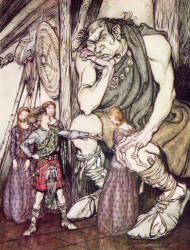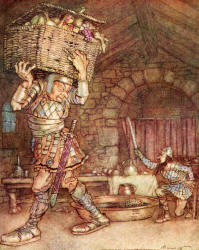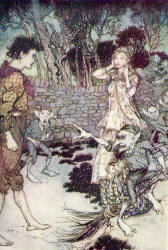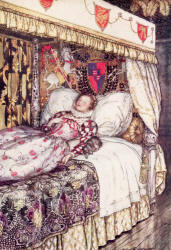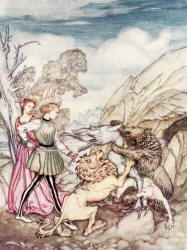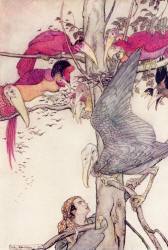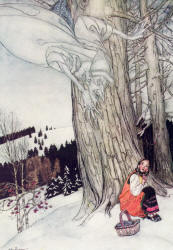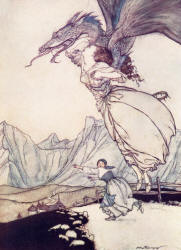"The Allies'
Fairy Book" (1916)
Illustrated by Arthur Rackham
"The Allies' Fairy Book" (1916) included a
selection of traditional fairy tales from the Allied countries participating in
World War I, including
'Jack the Giant Killer' (English); 'The Battle of the Birds'
(Scottish); 'Lludd and Llevelys' (Welsh); 'Gulesh' (Irish); 'The Sleeping Beauty
(French);
'Cesarino and the Dragon' (Italian); 'What came of picking
flowers' (Portuguese); 'The Adventures of Little Peachling', 'The Fox's Wedding'
and
'The Tongue-Cut Sparrow' (Japanese); 'Frost' (Russian); 'The
Golden Apple-Tree and the Nine Peahens' (Serbian); and 'The Last Adventure
of Thyl Ulenspiegel' (Belgian).
Comment within the Introduction by Edmund Gosse
provides an interesting insight into the contemporary events relevant to the collection thus:
In presenting a selection of the fairy-stories of the
Allies we make no the slightest pretence of
being logical or historical. We are conscious of all the
objections which may be brought against
us by the learned, and we do not seek to rebut them. We
are perfectly aware of the fact that
variants of the stories we have chosen can be pointed out
in the folk-lore of other nations than
those with whom we have the happiness to be joined in our
great national struggle to preserve
the civilization of the world. But we think that the form
in which every story we have chosen is
told, although perhaps not the essence o the story
itself, is characteristic of each particular
country, and all that wee need say more is that it has
amused us to bring together specimens
of the folk-lore of the fighting friends of humanity.
We have not forgotten the almost universal distribution
of fairy-tales, and the uniformity with
which certain tradition reappears in the legends of one
country after another. The "people of
peace" have not politics and are ignorant of the elements
of patriotism; at all events they own
no allegiance to the particular States which they
inhabit, and we cannot be sure what part they
take in the quarrels and dissensions of mankind. So
independent of racial prejudice are those
creatures of the supernatural world that the only law
they seem to recognize is the primitive one:
Be kind to those who are kind to you.
For "The Allies' Fairy Book" (1916), Rackham
produced a suite of 12 colour illustrations and more than 20 monotone drawings.
Upon release, Rackham's suite received critical praise in
both his home market and the United States of America, including that appearing
in The Burlington Magazine for Connoisseurs (Vol 29; 1916):
A pretty idea, to choose a fairy tale from the lore of
each of the Allies, and bring them together
to show how much is in common. England, Scotland, Ireland
and Wales each contribute one,
and Japan three; so here are thirteen fairy-stories, and
an introduction (written with all the
renowned grace of Edmund Gosse), which may open the eyes
of readers, adult and infant,
to the fascinating significance which modern research
finds in the lore of the folk and the
children. Mr Rackham's twelve colour-plates are right
Rackham; and Rackham with more
power and wealth in it than this artist's overworked
fancy has always been able to exhibit of
late. There are lots of little decorations, too, by the
same hand, which are delicious.
|
.jpg)
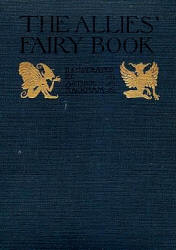
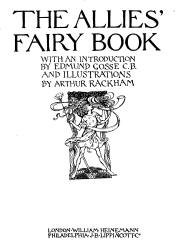
%20(sample).jpg)
%20(sample)%20(rear).jpg)
.jpg)
